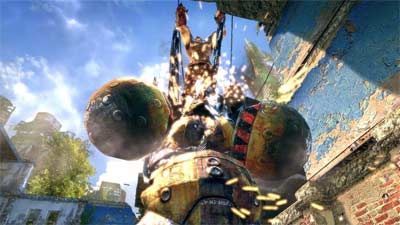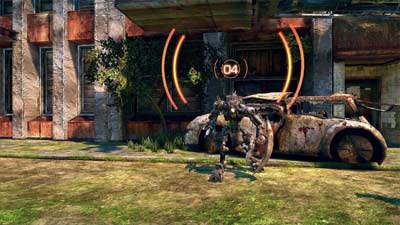Future Slavery
Enslaved: Odyssey to the West is basically a whirlwind tour of everything that’s popular in third-person action games these days. In fast succession, players encounter it all: platforming, melee combat, teamwork, vehicle and turret sequences, puzzles, stealth, shooting, and plot. This isn’t the most innovative game on the market, and it doesn’t do anything spectacularly well. But the developers made this entire smorgasbord of play styles flow into each other nicely, and virtually every aspect of Enslaved feels polished and competently constructed. More important, this title is just plain fun to play and hard to put down. In short, it’s definitely worth at least a playthrough.

The plot is a science-fiction take on the classic Chinese story Journey to the West, with some extra ideas cribbed from The World Without Us (a book by Alan Weisman, who envisions what Earth would be like without humanity and likes what he sees). As the game begins, it’s 150 years in the future. The protagonist, Monkey, is trapped on a spaceship as a slave when all hell breaks loose and the ship starts to crash. Monkey flees from his cell and makes his way to the ship’s escape pods. A fellow slave beats him to the last available pod, however, and Monkey clings to the outside as the pod ejects and plummets to the ground. It lands in New York City — or what used to be New York, anyway. The skyscrapers are crumbling, and colorful, beautiful vegetation has grown around them. There are no people, and there are no hints as to what happened to cause this state of affairs.
Having miraculously survived the fall (his cartoonishly large muscles must have cushioned the blow), Monkey awakens from unconsciousness to find himself with Trip, the slave who’d beat him to the escape pod. She informs him that she put a slave collar on him while he was out. This means two things: she can control his mind whenever she wants to; and if she dies, he dies. He has no choice but to help her survive. After some initial bickering, during which Monkey vows to kill Trip as soon as the collar comes off, they set off to find what’s left of Trip’s old village, and the adventure begins.
Much of the gameplay time is spent simply traversing the terrain in an almost perfectly linear manner. There’s a fair amount of Uncharted-style platforming, but these sections exist more to occupy you than to challenge you. Monkey springs from one handhold, pole, or ledge to another with the simple push of a button, and he’ll refuse to jump if you try to leap in the wrong direction. Every once in a while, you’ll have to carry Trip through some hazards, or toss her to a ledge she can’t reach on her own, or create a bridge for her to cross. The only way to die while platforming is by failing to jump quickly enough when something you’re standing on starts to fall.

Fortunately, the exploration is broken up by battles against the lethal mechs that now inhabit New York. By combining a few simple mechanics in an interesting way, the developers made these fights feel unique, even though there’s really nothing about them that hasn’t been done before, and better.
Early in the game, Trip, who’s a technical whiz, wires a dragonfly to act as a spy camera. Using the dragonfly, she checks out each group of mechs before you fight them. Most mechs are dormant to begin with, and the dragonfly clearly indicates how far each mech can see. Sometimes, there’s room enough that you can sneak past the mechs without even battling them, giving Enslaved a small helping of stealth.

Most of the time, however, you have to fight. Your weapon of choice is your staff, which can be used both to strike your enemies with light and heavy attacks, and as a gun that shoots plasma and stun rays. You also have a shield and can evade attacks. The fights can feel like button-mashing sessions sometimes, and some control issues get in the way (the long animations make it difficult to time your button presses), but they do a decent job of blending mindless fun with some light strategy.
There are a few ways to make the fights easier. With some mechs, you can perform a “takedown,” which not only kills the mech but helps you kill the others, too; you either take the mech’s weapon, use the mech’s body as a shield, or rip the mech apart, stunning the surrounding mechs with electricity. Also, some mechs are turrets, and you can have Trip distract them while you flank and destroy them. Further, by collecting the orbs that are strewn throughout the world, you can save up currency and purchase upgrades to your health and combat abilities.

There are also some puzzles here, but they’re a little too easy and clichéd for our tastes. They usually involve flipping switches, raising and lowering bridges, or finding your way from point A to point B. We can honestly say that we never really felt challenged, even when the puzzles required cooperation between Monkey and Trip. This can make the game accessible to players who aren’t good at problem-solving, but it makes the game a little boring for the rest of us.
Another mechanic you’ll encounter is the cloud, which is basically a hoverboard that works only in certain sections. We felt it was a bit underused, but it makes for some high-speed, white-knuckle chase scenes and boss fights. If there’s a sequel, we expect to see more of it.
We also expect a sequel to make better use of teamwork. Surprisingly enough, Enslaved doesn’t require a whole lot of it beyond the aforementioned basics (switch-flipping puzzles, distracting turrets, etc.). Trip isn’t in danger very often, and she doesn’t even fight alongside you. Essentially, the game doesn’t do anything interesting with the fact that it’s basically one big escort mission.
Then again, perhaps this is why Trip seems to function so much better than most AI partners. She doesn’t get herself killed, get stuck while walking to the next part of the game, or block your way in close quarters. Sure, we’d have liked to see a little more cooperative play, but given how abysmally most AI partners perform, we were glad just to have her stay out of the way.
The graphics here are terrific on a creative level, but leave something to be desired on a technical level. The developers brought out the colors and life of a green, overgrown, post-apocalyptic world, and the facial animations are terrific. This is especially evident in the cutscenes, which are brief but advance the story convincingly nonetheless. However, the framerate drops from time to time, textures pop in, some animations are overused, and periodically the game will freeze and load for a second. Enslaved utilizes the Unreal engine, so there’s really no excuse for it not to run smoothly, but these little glitches don’t detract too much from the overall experience.
The developers also did a good job with the sound. Some fragments of dialogue are used too often, but the voice acting is superb, and the music enhances the atmosphere of the game without distracting any attention from it. The sound effects feel completely natural, and gunshots reverberate thunderously in big rooms.
One last minor complaint: the checkpoint system is irritating. They developers were generous with what we’ll call mini-checkpoints — checkpoints that you return to when you die, but that disappear when you turn off the game (or opt to restart from the last checkpoint). Checkpoints that actually save, meanwhile, occur considerably less frequently, and sometimes it’s hard to remember when the last one even was. This forces you to keep playing for a while after you decide to stop, just to avoid losing ground. It’s a small thing, but it would have been easy to fix.
Enslaved takes about ten hours to finish on Normal mode, which is challenging here and there, but overall manageable even for the non-hardcore. Unless you’re an achievement hound, there’s really not much of a reason to go through it a second time. There’s no multiplayer, either, so most gamers can get their fill by renting it or borrowing it from a friend.
Nonetheless, we had a lot of fun working our way through the campaign, and we highly recommend other action fans do the same. It may not be Game of the Year material, but it’s definitely a good game with which to spend a weekend.
RATING OUT OF 5 RATING DESCRIPTION 4.1 Graphics
The environments are beautiful and the facial animations are some of the best we’ve seen, but there are some technical problems like pop-in. 3.5 Control
They’re fine by and large, but they can be clunky during combat. 4.7 Music / Sound FX / Voice Acting
The game has great sound effects, music, and voice acting. 3.8 Play Value
It’s a great ten-hour campaign, but there’s little replay value. 3.9 Overall Rating – Good
Not an average. See Rating legend above for a final score breakdown.
Game Features:
